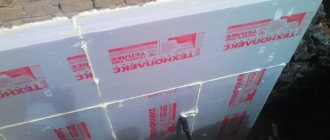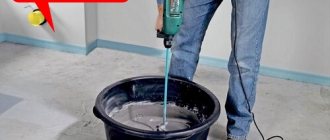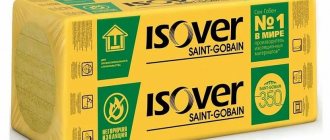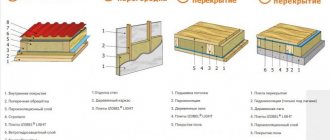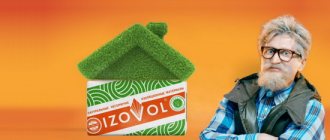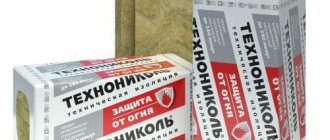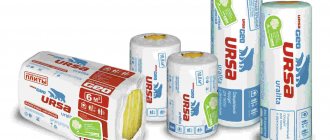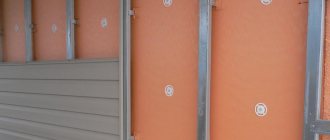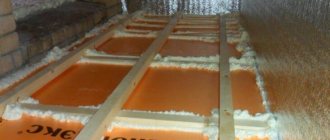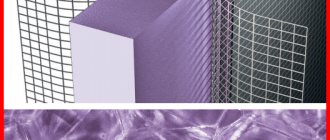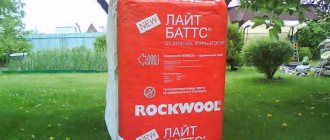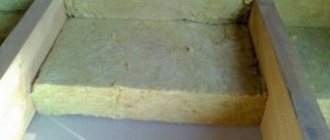Technical and physical characteristics of the material
The manufacturer indicates the performance and other properties of the insulation on the packaging. Having carefully studied the instructions, you can understand that the technical characteristics of Technoplex (50 mm) look like this:
- sheet thickness – 50 mm;
- average density of the material – 26-30 kg/m³;
- compression resistance – up to 25 tons/m²;
- material water absorption rate (per day) – 0.2% of the total volume;
- use in the temperature range – from -70 to +75°C;
- flammability class - G4;
- heat capacity indicator – 1.45 kJ;
- vapor permeability coefficient – 0.01 m/h/Pa;
- bending strength – not less than 0.3 MPa.
As you can see, with low weight and minimal thickness, the material has the ability to withstand heavy loads, which significantly expands the scope of its application.
It is also important that this type of insulation is not prone to rotting or infestation by rodents and fungi. During operation, it does not emit harmful substances into the air and remains resistant to most chemical compounds (except gasoline and organic solvents)
What is the difference between the materials
- Some performance differences between Penoplex and Technoplex are due to slightly different production technologies and cooling methods for the extruded material. According to Technonikol, Technoplex is produced without the use of freon compounds.
- Adding various additives that improve the properties of insulating boards. Technoplex is distinguished by the presence of graphite nanoparticles in its composition, which increases the overall strength of the material.
- The mechanical bending strength of the Penoplex device can reach 0.7 Pa compared to the average value of 0.3 Pa for the Technoplex device. It should be noted that these values are serious and both materials can withstand normal loads.
- The specified operating temperature of the Penoplex device starts at a temperature of -70°C, Technonikol guarantees the preservation of the properties of the product at a temperature of -50°C. The difference, of course, is significant, but not relevant for the central zone of Russia.
- There is a slight difference in prices for these products, but it is not absolute and depends mainly on the region and manufacturer.
Dimensions of extrusion insulation
In order to correctly determine the required number of slabs, you should study in more detail the characteristics of Technoplex 50 mm. How many slabs are in the package, and what size they are, you can, of course, check with the seller, but it is better to have this information in advance.
So, from information from the manufacturer we know that the described slabs come in two types:
- with dimensions 118 x 58 cm;
- size 120 x 60 cm.
Also, insulation sheets can have different widths (from 20 to 100 mm). But since slabs with a width of 50 mm are considered the most universal, our article is devoted to them. One package contains 6 slabs of the same size.
Video description
A comparison of both insulation materials is clearly shown in the video.
Since both insulation materials have the same source material, they are harmless to the environment and humans, and are not afraid of almost any building mixtures or solutions. Throughout the entire service life, subject to operating conditions, no harmful substances are released. The flammability of both insulation materials is the same: they easily ignite and release asphyxiating substances. It is recommended to pre-treat the sheets with fire-retardant compounds.
Installation of both materials is similar and does not require special knowledge; a novice master can easily handle it.
Despite the strong similarity, most often the choice is made in favor of Penoplex. There are several reasons for this:
- Price . Penoplex is about 10-15% cheaper than Technoplex. For large volumes of work, the difference in cost can be significant.
- Sheet size . Both insulation materials have similar widths (58 and 60 cm) and thickness (from 2 to 15 cm), only the length differs. "Penoplex" is sold in slabs 120 cm long, less often 240 cm (only at maximum density). "Technoplex" is produced in the form of sheets of various lengths: 120, 240, 300, 400, 450 cm.
Insulation from outside Source avrora-sm.ru
Application and types of penoplex
Considering that penoplex has a number of advantages, its scope of application is quite extensive. EPS serves as an excellent insulation material both indoors and outdoors. It is perfect for apartments, houses, cottages and other buildings. Penoplex can be used to insulate roofs, attics, and balconies, in any climatic region without the use of an additional moisture-proof layer. Since the material practically does not absorb water, it is quite possible to use it in an environment with high humidity. At the same time, its thermal conductivity remains almost unchanged. EPS sheets of various thicknesses are available for sale, and depending on the specific requirements, you can always choose the best option.
In addition to a variety of sizes, extruded polystyrene foam is available in several types depending on density and application. Let's look at each type:
Penoplex Wall. The old name is Penoplex 31 with fire retardants. This material has a density of 25-32 kg/m³ and is intended for effective insulation of external and internal walls, partitions, and plinths. These slabs are also used in the construction of buildings when constructing walls using “well masonry”. Compared to traditional brick walls, such walls are much thinner, but are not inferior to them either in reliability or in the ability to retain heat. In case of insulation of external walls with penoplex, a plaster system can be made on top of the insulation using a mesh, or it can be lined with any façade cladding material (siding, tiles, lining).
Penoplex Foundation. The old name is Penoplex 35 without fire retardant. This material has a density of 29-33 kg/m³ and has high thermal insulation characteristics, a minimum coefficient of water absorption and resistance to chemical and biological destructive factors. Its water-repellent ability allows it to be used as a waterproofing coating. Penoplex Foundation is a rigid slab with a stepped edge, used in the construction of basements, foundations, and insulation of septic tanks. The slabs are very durable and can withstand significant loads. Therefore, they can also be used as a basis for garden paths, plinths, and floors.
Penoplex Roofing. The old name is Penoplex 35. This material has a density of 28-33 kg/m³ and well insulates the building from cold air, has minimal water absorption, the ability to insulate noise well, and has a long service life. The slabs have a standard size of 600x1200 mm, but if necessary they can be easily cut with any available tool. And the light weight of the slabs allows them to be used without reinforcing roof structures. The stepped edge located along the perimeter acts as an additional guarantee that “cold bridges” will not form at the joints of the slabs. This type of penoplex can be used to insulate any type of roof. However, more often this insulation is used for insulating flat roofs, as well as for insulating the attic space of a ventilated roof.
Penoplex Comfort. The old name is Penoplex 31C. This material has a density of 25-35 kg/m³ and has an extremely low thermal conductivity coefficient, high hydrophobicity, and excellent ability to insulate noise. It does not rot and is not a favorable environment for the settlement of insects, mold and fungi. Penoplex Comfort is produced in the form of slabs measuring 600x1200 mm, which have a step-shaped edge along the perimeter. It serves as an additional guarantee of accurate installation. Being a kind of universal, this insulation is simply ideal for thermal insulation of a private house. They can be used to insulate floors, foundations, basements, roofs and walls.
Penoplex 45. This material has a density of 35-47 kg/m³ and is used as insulation for road surfaces, in particular runways, to prevent them from frost heaving of the soil and destruction of the top layer of the road surface. It is also widely used for insulating roofs in use, on which there are pedestrian areas and various areas, including parking lots.
Extruded polystyrene foam as a sound insulator
The use of extruded polystyrene foam for soundproofing walls and floors can be considered atypical. Initially, this material was intended for the construction of a thermal insulation layer in various structures, but quickly found wider application. Tests have revealed that it absorbs impact noise well, so it can be used in wall and floor structures for this purpose as well. The 20 mm thick thermal insulator is capable of absorbing up to 23 dB of impact noise. Not that much, however. For example, in order for the sound insulation of a floor made of extruded polystyrene foam to make itself felt, the thickness of the insulation must be at least 40 mm. In addition, the specific design of the wall and ceiling plays a role. This property of penoplex - to absorb a little noise - can be called a pleasant addition, nothing more. Here is another reason why flooring with extruded polystyrene foam has become increasingly popular lately. Builders prefer to use special sound insulators - rolled material, the thickness of which is 1-2 cm is enough to protect the apartment from noisy neighbors.
So it’s not possible to hope to insulate the house and at the same time isolate yourself from noise using ordinary extruded polystyrene foam. In order to provide effective sound absorption, there are special wall panels. The heat insulator in it acts as the “golden mean”, while the sides of the panels are laminated with foamed polyethylene foam, rubber, polymer cement, fiberglass mesh is introduced into the structure, etc. In other words, the same noise absorbers are added. This kind of extruded polystyrene foam is very suitable for soundproofing walls and floors. Such panels are distinguished by a smooth outer side, ready for finishing, and therefore are very convenient to use.
Panels made of extruded polystyrene foam “in a shell” are usually called sandwich panels. Do not confuse construction sandwich panels, in which the insulation is “rolled” into steel or cement-bonded sheets, with soundproofing panels intended for sound insulation and finishing of the room.
So, if you need to arrange not only thermal insulation, but also protection from extraneous sounds, you need to look for a material called a soundproof wall panel made of extruded polystyrene foam - the price for it will vary depending on the manufacturer and design features. The size of the panels is usually standard - 60 cm x 250 cm, thickness varies from 2 to 10 cm. The cost of one panel (20 mm thick) is from 1300 to 2.5 thousand rubles.
Summarize. It is possible to talk about the possibility of soundproofing floors, walls, and ceilings using extruded polystyrene foam, but with reservations. The following should be kept in mind:
- Extruded polystyrene foam by itself does not provide good sound absorption
- In order to provide sound and heat insulation in one fell swoop, it is recommended to use soundproofing wall panels made of extruded polystyrene foam, the price of which is quite high
- You can reduce the cost of the solution by additionally using a roll sound insulator such as “Shumanet”, “Isofon”, etc.
Getting 2-in-1 at an affordable price - ceiling insulation and sound insulation - is just a great idea. Soundproofing panels based on extruded polystyrene foam in this case are what you need. Their installation will be quite simple, and the finishing will not require additional preparation, which is also an undoubted benefit.
Description and features of the material
Technoplex insulation is made from polystyrene granules, which, under the influence of high temperature and high pressure, are mixed with a special foaming composition and graphite. The viscous mass is sent into molds of a certain size, where it hardens and is cut into sheets of standard parameters.
The final product is smooth and dense. The structure of the sheet consists of a large number of small closed cells that do not allow air to pass through. Thanks to this, the characteristics of Technoplex (50 mm) are quite high. Graphite additives significantly improve the thermal insulation abilities and increase the strength of the slabs.
Products are sold in rectangular packaging, the size and weight of which depends on the size of the material.
Positive features of the material
The technical characteristics of Technoplex (50 mm thick) indicate that this material allows you to significantly save your budget, since it has improved heat-insulating qualities. Compared to conventional polystyrene foam, the capabilities of this product are two times higher, and if you look at the thermal insulation performance of fiberglass slabs, it becomes clear that their capabilities are 1.5 times less.
In addition, a number of positive properties of the material should be noted:
- Increased strength. The extrusion material is more than 5 times stronger than polystyrene foam.
- High density. "Technoplex" is able to withstand heavy loads, which makes it possible to use it when arranging floors.
- Resistant to moisture. The dense and solid structure of the material does not allow moisture to pass through, while polystyrene foam is capable of absorbing liquid, albeit in small quantities.
Despite the fact that the Technoplex material (50 mm) has quite high characteristics, it still has one drawback - poor vapor permeability. This fact must be taken into account when purchasing extrusion plates for certain jobs.
What to choose
If we compare these two insulation materials, then Technoplex is more technologically advanced and has better qualities, but the difference between it and Penoplex is so insignificant that it is impossible to say for sure which one should be chosen.
By choosing polystyrene foam insulation, regardless of whether it is Technoplex or Penoplex, you can get not only thermal insulation, but also sound and vapor barrier.
Please note: the service life of extruded polystyrene foam boards is more than 50 years, which is a long time. However, it is worth remembering that polystyrene foam is still a chemical insulation, not a natural one.
Therefore, when burned, it releases very corrosive substances
However, it is worth remembering that polystyrene foam is still a chemical insulation, not a natural one. Therefore, when burned, it releases very caustic substances.
Installation features
The process of installing the material itself is simple and will require the performer to have minimal construction knowledge and tool skills. To carry out installation we will need the following tools and consumables:
- perforator;
- hammer and spatula;
- sharp knife;
- tape measure and level;
- marker;
- directly technoplex of the required brand and thickness;
- special plastic dowels with a wide head;
- adhesive mixture for polystyrene foam;
- metal support profile.
When the materials and tools are ready, you can begin installation. First you need to prepare the surface. Most often, technoplex is used for external insulation of a facade or foundation, so the surface must be fairly flat (there is no need to inject it to the nearest millimeter) and clean. Some professionals recommend additionally priming the wall or foundation for better adhesion of the adhesive. This step will not be superfluous, although it is not mandatory.
After preparing the surface, you can begin installing the technoplex. To begin with, the lower horizontal rail made of a metal profile is leveled and secured. When choosing a batten, it is necessary that its width matches the thickness of the insulation board. Then we attach the top rail.
We begin to lay polystyrene foam boards between the guides. To do this, lubricate the surface with glue and press it against the wall (foundation). We check the correct installation using the level. Considering that the solution hardens for a certain time, it is possible to slowly adjust the location of each slab relative to the level to achieve the desired result.
After the glue has completely dried (usually after 2-3 days depending on the brand of the mixture), we proceed to additional fixation of the slabs. To do this, use a hammer drill to drill holes in the surface through the insulation and insert plastic dowels. Due to their design, they have a hollow body and teeth on the outside of the nail. We hammer a steel rod into a special hole, which deforms the dowel from the inside and forces it to be firmly held in brick or concrete.
As a rule, 5 dowels are driven into one slab - 4 at the edges so that the head fixes the adjacent slabs and 1 in the center. Sometimes, in order to save money, they are content with less.
The installation is complete, now you can begin finishing the exterior surface.
Description and features of the material
Technoplex insulation is made from polystyrene granules, which, under the influence of high temperature and high pressure, are mixed with a special foaming composition and graphite. The viscous mass is sent into molds of a certain size, where it hardens and is cut into sheets of standard parameters.
The final product is smooth and dense. The structure of the sheet consists of a large number of small closed cells that do not allow air to pass through. Thanks to this, the characteristics of Technoplex (50 mm) are quite high. Graphite additives significantly improve the thermal insulation abilities and increase the strength of the slabs.
Products are sold in rectangular packaging, the size and weight of which depends on the size of the material.
Packaging and storage
The boards are packaged in UV-stabilized film. For ease of unloading, the slabs are laid on foam blocks.
Storage: it is not possible to store XPS TECHNOPLEX slabs under a canopy that protects them from precipitation and sunlight. When stored under a canopy, the slabs should be placed on pallets, stands or bars. It is allowed to store XPS TECHNOPLEX boards outdoors in special packaging that protects them from external atmospheric influences.
Precautionary measures: keep away from fire. Chemically unstable to gasoline, organic solvents, as well as bitumen adhesive with a high content of organic solvent.
The material is produced in sheets measuring 600x1200 mm and thicknesses of 20,30, 40 and 50 mm, and its edge can be smooth or L-shaped (to prevent the appearance of cold bridges and the formation of dampness on the walls).
Technical and physical characteristics of the material
The manufacturer indicates the performance and other properties of the insulation on the packaging. Having carefully studied the instructions, you can understand that the technical characteristics of Technoplex (50 mm) look like this:
- sheet thickness – 50 mm;
- average density of the material – 26-30 kg/m³;
- compression resistance – up to 25 tons/m²;
- material water absorption rate (per day) – 0.2% of the total volume;
- use in the temperature range – from -70 to +75°C;
- flammability class - G4;
- heat capacity indicator – 1.45 kJ;
- vapor permeability coefficient – 0.01 m/h/Pa;
- bending strength – not less than 0.3 MPa.
As you can see, with low weight and minimal thickness, the material has the ability to withstand heavy loads, which significantly expands the scope of its application.
It is also important that this type of insulation is not prone to rotting or infestation by rodents and fungi. During operation, it does not emit harmful substances into the air and remains resistant to most chemical compounds (except gasoline and organic solvents)
Expanded polystyrene for insulation "TechnoNIKOL"
Features and differences
The material is available in the form of slabs of different thicknesses.
Expanded polystyrene (EPS) is one of the types of foamed plastics used in construction for thermal insulation of various structures and components. The material is highly efficient and easy to install, which is why it is popular among builders - in the private and industrial sectors.
The surface of the insulation has perforations to increase adhesion (adhesion).
Insulation based on foamed polystyrene was invented more than 80 years ago, but at that time its use had many limitations associated with flammability, low strength and a relatively short service life.
For foaming, a propane-butane mixture of gases was used, which burns on its own. But polystyrene itself supports combustion well, releasing toxic smoke.
The flammability of PPS has long remained its main disadvantage.
The use of flammable insulation materials poses a real danger.
Expanded polystyrene TechnoNIKOL is free from these disadvantages:
- Does not contain flammable gas. Polymer granules are mixed at high temperature and pressure with a foaming agent, which consists of carbon dioxide and light freons. These gases not only do not burn, they prevent the combustion of other materials, in particular, they lead to the attenuation of polystyrene;
- Contains flame retardants. Special substances are added to the composition of expanded polystyrene - fire retardants. These may be ammonium or boron phosphates and chlorides, as well as other compounds that retard combustion, limit the spread of flame and lead to self-extinguishing of materials to which they are added;
- Extruded polystyrene foam (XPS). produces polystyrene foam boards using the extrusion method. The result is a material with closed cells measuring 100-200 microns, a uniform structure, increased compressive strength and almost zero water absorption.
Extruded boards are characterized by increased density and thermal insulation.
TechnoNIKOL PPS does not absorb water.
Characteristics and varieties
The slabs have an L-shaped edge for a tighter joint.
Let's look at the main technical characteristics of extruded polystyrene XPS TechnoNIKOL CARBON ECO:
| Index | Meaning |
| Thermal conductivity at a temperature of 25 °C, W/m*K (according to GOST 7076-99) | 0,029 |
| Density, kg/m³ | from 26 to 32 |
| Compressive strength at ten percent linear deformation, MPa (according to GOST 17177) | 0,25 |
| Bending strength, MPa (GOST 17177) | 0,25 |
| Thermal conductivity under operating conditions “A”, W/m*K (according to SP 23-101-2004) | 0,034 |
| Thermal conductivity under operating conditions “B”, W/m*K (according to SP 23-101-2004) | 0,034 |
| Water absorption coefficient, % (according to GOST 15588) | 0,2 |
| Vapor permeability coefficient, mg/m*h*Pa (GOST 25898-83) | 0,011 |
| Flammability group (according to GOST 30244) | G3 (for plaster facades), G4 |
| Specific heat capacity, kJ/kg* °C (according to SP 23-101-2004) | 1,46 |
| Modulus of elasticity, MPa | 17 |
| Operating temperature range, °C | from -70 to + 75 |
| Varieties | CARBON ECO SP, CARBON ECO FAC, CARBON DRAIN, XPS TECHNOPLEX, XPS CARBON SOLID, XPS CARBON PROF, XPS CARBON PROF SLOPE |
Carbon particles give the slabs a gray tint.
The name of the material uses the term “Carbon”: this is not just a marketing ploy. Insulation boards are saturated with carbon nanoparticles, which reduce its thermal conductivity and increase mechanical strength. It is carbon that gives the slabs their characteristic dark silver hue.
Carbon expanded polystyrene has many unique advantages.
XPS TECHNONICOL CARBON ECO SP is used in shallow foundation systems.
Technoplex is another popular type of TechnoNIKOL product.
Technoplex insulation technical characteristics
Technoplex extrusion has a low thermal conductivity coefficient, is resistant to mechanical loads, does not shrink, is chemically resistant, and is not subject to decomposition and rotting. Technoplex has technical characteristics in comparison with brick such that the thermal conductivity of 30 mm extruded polystyrene foam is comparable to a 400 mm brick wall. Finnish foundations are often insulated with this material.
Technoplex 50 mm characteristics
Technoplex.
Characteristics of slabs with a thickness of 20 to 120 mm The scope of application of extruded polystyrene foam, due to its high strength and resistance to moisture, is very wide. XPS is used today when pouring USP, insulating strip foundations and blind areas of houses. The material does not lose its original characteristics even in water, since the structure of the material consists of closed cells that do not absorb moisture, unlike mineral wool.
What is foam plastic
As the name suggests, polystyrene foam is foamed plastic. There are many plastics, so foam can be understood as polyurethane foam, polyvinyl chloride foam, corbamido-formaldehyde, polystyrene foam, etc.
But it just so happens that when we hear the word “foam plastic,” we imagine a white cellular structure, which is often used not only in construction, but also in packaging, medical containers, and other industries. This substance is polystyrene foam.
Foam plastic (expanded polystyrene without pressing)
As we remember, polystyrene foam and polystyrene foam are essentially the same thing, but let’s not forget about the power of habit and tradition. Pressless polystyrene foam is the same foam that is white and has pimples.
The raw material for producing BSP is the same as for any other expanded polystyrene - polystyrene
. Due to such a different approach to the production of EPS, the result is a very different product. These differences are clearly visible due to the known performance characteristics of these materials.
BSP is produced by adding granules with pentane or other low-boiling liquid to styrene, then the mixture is heated, the granules expand and the foam fills the mold. The granules are then sintered in a special autoclave until the styrene polymerizes.
The result is a white material consisting of small bubbles glued together. 98% of the volume of the heat insulator is air.
This is a fairly fragile material that crumbles and breaks.
Here are its technical characteristics:
- Thermal conductivity
: 0.335 – 0.41 W/m*K dry (+5 – +25); - Density
: 11 – 35 kg/m³; - Vapor permeability
: 0.012 mg/m*h*Pa; - Compressive strength
: 0.05 – 0.16 MPa; - Bending strength
: 0.07 – 0.25 MPa; - Maximum slab humidity
: 1%; - Water absorption
for 24 days – 1%; - Flammability class
: G1; - Self-burning time
: up to 3 seconds; - Service life
– 20 – 50 years.
As you can see, we have a fairly brittle and weak compressive material, which has a very low thermal conductivity coefficient. If we talk about the flammability of foam plastic, we must remember that according to GOST 15588-2014, material with flammability class G1 is approved for construction work, that is, it burns worse than wood.
For use in ventilated facades, any foam plastics are undesirable. It is better to choose mineral wool.
Extruded polystyrene foam
Let me remind you once again: is polystyrene foam plastic or not? Yes, this is polystyrene foam, but a specific type of it. Among builders, extruded polystyrene foam is considered to be extruded polystyrene foam. It is also often called extrusion (EPS, XPS).
The whole difference lies in the method of production of the material
. It is made by extrusion: polystyrene granules are mixed under pressure and at high temperature with a foaming agent and squeezed through an extruder, which gives the mass the desired shape. In addition, the material is obtained with
Cutting finished products into slabs.
Let's look at the technical characteristics of EPS:
- Thermal conductivity
: 0.028 – 0.039 W/m*K; - Density
: 26 – 45 kg/m³; - Vapor permeability
: 0.18 – 0.02 mg/m*h*Pa; - Compressive strength at
10% deformation: 0.25 – 0.47 N/mm²: - Bending strength
: 0.4 – 0.96 N/mm²: - Water absorption over 24 hours
, in% by volume: 0.2; - Flammability group
: G1; - Ability to independently maintain combustion
: no more than 2 seconds; - Durability
: up to 50 years.
Production technologies can change many parameters. We see that the extrusion method produces a more advanced insulation, while using completely identical raw materials. Now it’s much easier to answer, which is better, PSB or EPPS?
Extrusion polypropylene also has its disadvantages. Its price is noticeably higher than that of polystyrene foam, it weighs more and has lower vapor permeability. And this negatively affects the microclimate in the room (or requires good ventilation).
Dimensions of extrusion insulation
In order to correctly determine the required number of slabs, you should study in more detail the characteristics of Technoplex 50 mm. How many slabs are in the package, and what size they are, you can, of course, check with the seller, but it is better to have this information in advance.
So, from information from the manufacturer we know that the described slabs come in two types:
- with dimensions 118 x 58 cm;
- size 120 x 60 cm.
Also, insulation sheets can have different widths (from 20 to 100 mm). But since slabs with a width of 50 mm are considered the most universal, our article is devoted to them. One package contains 6 slabs of the same size.
Which is better: technoplex or penoplex
When building any house in Russia, owners ask themselves about its insulation. Today, the insulation market has a large number of items; tiled thermal insulation materials are in particular demand. Among them, technoplex and penoplex have proven themselves. To better understand their properties, you need to make a small comparison of the main characteristics.
Composition of materials and method of their production
Extruded polystyrene foam or penoplex refers to tile heat insulators. It is produced by extrusion from polystyrene.
This method allows you to achieve a uniform structure of the material, consisting of tiny cells with air.
During production, polystyrene granules are mixed at high temperature and pressure, and a foaming agent (light freons with carbon dioxide) is introduced into the mixture. The next stage of production is extrusion. The resulting material has good thermal insulation properties.
Technoplex is also a tile material for thermal insulation. During its production, graphite nanoparticles are added to extruded polystyrene foam; they further reduce the thermal conductivity of the material, while increasing its strength.
Both materials are environmentally friendly, do not support combustion, and do not dissolve in water and soil. They are suitable for private construction, thermal insulation of balconies and the installation of “warm floors”.
Strength of materials
In terms of mechanical compressive strength at 10% deformation, penoplex (type 35) and technoplex XPS30-200 Standard have the same values of 250 kPa. This value depends on the density of the slabs.
The tensile strength during static bending of penoplex is, depending on the type, 0.4-0.7 MPa. The same indicator for technopex is 0.3 MPa. It can be concluded that penoplex is more resistant to static bending, as it can withstand greater loads.
Operating temperatures of materials
Operating temperatures of penoplex are from -50 to +75ºС. The operating temperature range for the technoplex is between -70ºС and +75ºС. Obviously, the temperature range of the technoplex is greater, this is its advantage, but -70ºС is rare even in our country.
Thermal conductivity and water absorption of penoplex and technoplex
The thermal conductivity of penoplex, depending on the type and operating conditions (A or B), is no more than 0.028-0.031 W/mK. This indicator for the technoplex under various operating conditions is 0.031 W/mK. Thus, both materials are effective thermal insulators.
The water absorption of technoplex is no more than 0.2% by volume in 24 hours. The water absorption of penoplex (type 35) is only 0.1%. Penoplex immersed in water for 28 days increases by only 0.2% of its volume. This indicates the negligible water absorption of penoplex.
In addition, this material is able to retain its properties after a large number of defrost-freeze cycles. For example, after 1000 such cycles, penoplex changes the thermal resistance by only 5%.
Price for penoplex and technoplex
Thus, penoplex and technoplex can be called similar materials, with slight differences in some indicators. Their main difference is the price.
Useful tips
- When using penoplex, you should rely on the manufacturer’s recommendations regarding the choice of insulation thickness depending on the temperature in your region of residence. So, in the central regions of Russia, to insulate the foundation, it will be quite enough to install extruded polystyrene foam with a thickness of 30-50 mm, and in the northern regions - material with a thickness of at least 80-100 mm.
- Before laying penoplex, be sure to prepare any foundations. Do not neglect this stage of installation work, otherwise the insulation will not adhere tightly and reliably to the base.
- Penoplex cannot be harmed by substances such as alcohols, alkalis, any acids, water, ammonia, propane, butane or freons. This insulation is manufactured taking into account high biostability, which makes it more durable and reliable.
- For internal insulation, it is recommended to use penoplex, the thickness of which is at least 20 mm.
- Please note that one of the most common mistakes made by home craftsmen is the incorrect selection of adhesive mixtures that are not suitable for the purchased insulation.
If you decide to insulate the floor in your house with penoplex, then you should use the installation method using logs.
Before purchasing penoplex, be sure to pay attention to its labeling. This way you will save yourself from buying the wrong material. Please note that insulating a home with penoplex should be carried out exclusively using special technology. Otherwise, the insulation will not last long and will be of little use. If you are afraid to take on such work, then it is better to entrust it to professionals.
You will learn more about penoplex in the following video.
Scope of application
In what types of work can Technoplex 50 mm be used? The characteristics and dimensions of the material practically do not limit the scope of its application, so it is very popular in many works.
Thus, Technoplex was actively used in the insulation of facades. For this purpose, it is mounted with a special glue (like polyurethane foam). Since extrusion slabs do not lose their properties even underground, they are used both to create a thermal insulation layer on foundations and as insulation for underground utilities.
The material is no less actively used in the process of interior decoration. It can be mounted both on vertical surfaces and in floor screeds.
Advantages of Technoplex thermal insulation
Extruded polystyrene foam (EPS) of various brands, for example, URSA XPS, Penoplex or Technoplex, is considered today the most effective and promising thermal insulation material in construction. Extrusion is produced in rigid slabs of different thicknesses. Let's take a closer look at the technical characteristics of technoplex and answer the question - penoplex or technoplex, what is the difference.
EPPS Technoplex is often used for thermal insulation of private houses (blind areas, foundations and basements), insulation of balconies and loggias, and as a substrate for “warm water floors”. The advantages of XPS Technonikol boards are high strength, which is combined with low thermal conductivity. TechnoNIKOL today offers building materials that meet all international standards.
Scope of application
In what types of work can Technoplex 50 mm be used? The characteristics and dimensions of the material practically do not limit the scope of its application, so it is very popular in many works.
Thus, Technoplex was actively used in the insulation of facades. For this purpose, it is mounted with a special glue (like polyurethane foam). Since extrusion slabs do not lose their properties even underground, they are used both to create a thermal insulation layer on foundations and as insulation for underground utilities.
The material is no less actively used in the process of interior decoration. It can be mounted both on vertical surfaces and in floor screeds.
Installation technology
When laying on horizontal surfaces - floors, flat roofs - the slabs are simply laid on a flat surface. The surface should be without sharp changes, the maximum deviation is 2-3%. This requirement must be met so that voids do not form. When laying, we monitor the joints; it is advisable to glue them (you can use tape) or fill them with the same foam/glue on which the slabs are attached.
When using Foam plastic for insulation of balconies
If two layers of thermal insulation are laid, it is positioned so that the EPS slabs of the second row overlap the seams of the lower one. They also say that the slabs are laid with alternating seams or “staggered”.
When mounting on vertical surfaces, double fastening is used:
- Glue or adhesive foam is applied to the plane.
- Additionally fixed with umbrella dowels.
According to the technology for installing slab insulation on facades, umbrella dowels are installed at the junction of two sheets (any two sheets) and two additional fasteners in the plane of the sheet. That is, there are at least 8 fasteners per sheet (indicated in red in the figure). More is possible. Less - no. Unless, of course, you want the insulation and finishing to come off. If the winds in the region are strong, it is better to put more. To insulate the inside, you can install less (see diagrams below).
Schemes for installing umbrella dowels when installing Penoplex on vertical surfaces
During installation, on the outer slabs and around openings, we install fasteners more often: three to four elements per slab. To keep the insulation rigid in the corners of the openings, a mesh is attached to it before plastering. It is attached at an angle of about 45°, securing the joint. Under such conditions, there will be no problems with finishing inside or outside.
If plaster, facade tiles, finishing stone and other heavy materials are subsequently applied to Penoplex, before installation, care must be taken to improve the adhesion of the material to the wall and to the finish. Even if you are installing a Penoplex Wall with stripes, it is better to add roughness to the slab using a metal brush. And from both sides. If the wall is smooth, it also doesn’t hurt to add roughness - for better adhesion.
If the wall is smooth, it also needs to be processed by putting a metal attachment on the drill
To work with Penoplex, a special adhesive mixture is recommended: Ceresit ST 84, illbruck PU 010, Titan 753, Ceresit CT-85, Kreisel 210 and 220, Baumit ProContact, STO Baukleber, Soudal Soudabond, Penosil Fix and Go, Den Braven, Krass.
